Greatest ever: Fighters #1 - P-51 Mustang
More P-51 Mustang Videos: 1 2 3 4 5 6 7 8 9 10 11 12 13 14 15 16 17 18 19 20 - P-51 Mustang Pictures
|
|
|
|
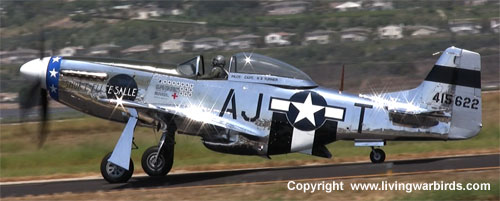
|
Manufacturer: North American Aviation Model: P-51D Year built: 1945 Serial Number: 4511483 Number of Seats: 2 Number of Engines: 1 Engine Type: Reciprocating Engine: Rolls-Royce V-1650-7 |
Role: Fighter
First flight: 26 October 1940
Introduction: 1942
Retired: 1984
Primary users: United States Army Air Forces, Royal Air Force, numerous others (see below)
Number built: 15,875
Unit cost: US$50,985 in 1945
Variants: North American A-36, F-82 Twin Mustang, Cavalier Mustang, Piper PA-48 Enforcer, North American Mustang X
History of the North American P-51 Mustang
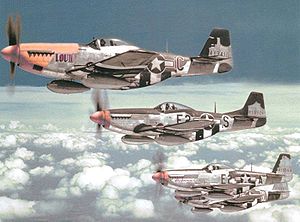
(Image: North American P-51 Mustangs of the 375th Fighter Squadron, 361st Fighter Group, summer 1944)
The North American Aviation P-51 Mustang was an American long-range single-seat fighter aircraft that entered service with Allied air forces in the middle years of World War II.
The P-51 flew most of its wartime missions as a bomber escort in raids over Germany, helping ensure Allied air superiority from early 1944. It also saw limited service against the Japanese in the Pacific War. The Mustang began the Korean War as the United Nations' main fighter, but was relegated to a ground attack role when superseded by jet fighters early in the conflict. Nevertheless, it remained in service with some air forces until the early 1980s.
As well as being economical to produce, the Mustang was a fast, well-made, and highly durable aircraft. The definitive version, the P-51D, was powered by the Packard V-1650-7, a two-stage two-speed supercharged 12-cylinder Packard-built version of the legendary Rolls-Royce Merlin engine, and was armed with six .50 caliber (12.7 mm) Browning M2/AN machine guns, a version of the Browning adapted for use in combat aircraft.
After World War II and the Korean conflict, many Mustangs were converted for civilian use, especially air racing. The Mustang's reputation was such that, in the mid-1960s, Ford Moto r Company's Designer John Najjar proposed the name for a new youth-oriented coupe after the fighter.
Design and Development
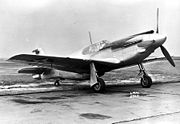
(Image: North American XP-51)
In 1939, shortly after World War II began, the British government established a purchasing commission in the United States, headed by Sir Henry Self. Along with Sir Wilfrid Freeman, who, as the "Air Member for Development and Production", was given overall responsibility for Royal Air Force (RAF) production and research and development in 1938, Self had sat on the (British) Air Council Sub-committee on Supply (or "Supply Committee"), and one of Self's many tasks was to organize the manufacture of American fighter aircraft for the RAF. At the time the choice was very limited: none of the U.S. aircraft already flying met European standards; only the Curtiss Tomahawk came close. The Curtiss plant was running at capacity, so even that aircraft was in short supply.
North American Aviation (NAA) was already supplying their Harvard trainer to the RAF, but were otherwise underutilized. NAA President "Dutch" Kindelberger approached Self to sell a new medium bomber, the B-25 Mitchell. Instead, Self asked if NAA could manufacture the Tomahawk under license from Curtiss.

Kindelberger replied that NAA could have a better aircraft with the same engine in the air in less time than it would take to set up a production line for the P-40. By now the executive head of the British Ministry of Aircraft Production (MAP), Freeman ordered 320 aircraft in March 1940. On 26 June 1940, MAP awarded a contract to Packard to build modified versions of the Rolls-Royce Merlin engines under licence; in September, MAP increased the first production order by 300.
The result of the MAP order was the NA-73X project (from March 1940). The design followed the best conventional practice of the era, but included two new features. One was a new NACA-designed laminar flow wing, which was associated with very low drag at high speeds. Another was the use of a new radiator design (one Curtiss had been unable to make work) that used the heated air exiting the radiator as a form of jet thrust in what is referred to as the "Meredith Effect". Because North American lacked a suitable wind tunnel, it used the GALCIT 10-foot (3.0 m) wind tunnel at Cal Tech. This led to some controversy over whether the Mustang's cooling system aerodynamics were developed by North American's engineer Edgar Schmued or by Curtiss, although historians and researchers dismiss the allegation of stolen technology; such claims are likely moot in any event, as North American had purchased Curtiss’ complete set of P-40 and XP-46 wind tunnel data and flight test reports for US$56,000.
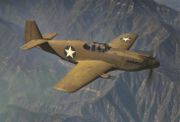
(Image: Early P-51 Mustang on a test flight. Note the 20mm cannon armament)
While the United States Army Air Corps could block any sales it considered detrimental or not in the interest of the United States, the NA-73 represented a special case. In order to ensure deliveries were uninterrupted, an arrangement was eventually reached where the RAF would get its aircraft in exchange for NAA providing two free examples to the USAAC for evaluation.
The prototype NA-73X was rolled out just 117 days after the order was placed, and first flew on 26 October 1940, just 178 days after the order had been placed — an incredibly short gestation period. In general the prototype handled well and the internal arrangement allowed for an impressive fuel load. It was armed with four .30 caliber Browning (7.62 mm) and two .50 M2 Browning (12.7 mm) machineguns in the wings and two .50 M2s in the chin.
(Image: A-36 Apache)
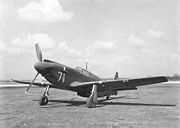
Allison-Engined Mustangs
Mustang I/P-51/P-51A
It was quickly evident that performance, although exceptional up to 15,000 feet (4,600 m), was markedly reduced at higher altitudes. This deficiency was due largely to the single speed, single stage supercharger of the Allison V-1710 engine, where power diminished rapidly above the critical altitude rating. Prior to the Mustang project, the USAAC had Allison concentrate primarily on turbochargers in concert with General Electric; these proved to be exceptional in the P-38 Lightning and other high-altitude aircraft, in particular, the Air Corp's four-engine bombers. Most of the other uses for the Allison were for low-altitude designs, where a simpler supercharger would suffice. The turbocharger proved impractical in the Mustang, and it was forced to use the inadequate supercharger available. Still, the Mustang's advanced aerodynamics showed to advantage, as the Mustang I was about 30 mph (48 km/h) faster than contemporary Curtiss P-40 fighters, using the same powerplant (the V-1710-39 producing 1,220 hp (910 kW) at 10,500 ft (3,200 m), driving a 10-foot-6-inch (3.2 m) diameter, three-blade Curtiss-Electric propeller). The Mustang I was 30 mph (48 km/h) faster than the Spitfire Mk VC at 5,000 ft (1,500 m) and 35 mph (56 km/h) faster at 15,000 ft (4,600 m), despite the British aircraft's more powerful engine.

(Image: The Mustang X AM203)
The first production contract was awarded by the British for 320 NA-73 fighters, named Mustang I by the British (the name being selected by an anonymous member of the Purchasing Commission). Two aircraft of this lot delivered to the USAAC for evaluation were designated XP-51. About 20 Mustang Is were delivered to the RAF, making their combat debut on 10 May 1942. With their long range and excellent low-level performance, they were employed effectively for tactical reconnaissance and ground-attack duties over the English Channel, but were thought to be of limited value as fighters due to their poor performance above 15,000 ft (4,600 m).
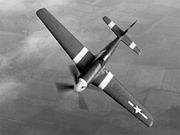
(Image: P-51B in flight showing wing planform)
A second British contract called for 300 more (NA-83) Mustang I fighters. In September 1940, 150 aircraft, designated NA-91 by North American, were ordered under the Lend/Lease program. These were designated by the USAAF as P-51 and initially named Apache, although this was soon dropped and the RAF name, Mustang, adopted instead. The British designated this model as Mustang IA. The Mustang Mk IA was identical to the Mustang Mk I except that the wing-mounted machine guns were removed and replaced with four long-barrelled 20 mm Hispano Mk II cannon.

(Image: USAAF P-51B-10-NA)
A number of aircraft from this lot were fitted out by the USAAF as F-6A photo-reconnaissance aircraft. The British would fit a number of Mustang Is with similar equipment. Also, two aircraft of this lot were fitted with Packard-built Merlin engines. These were identified as the Model NA-101 by North American and XP-78 by the USAAF, later redesignated XP-51B.
On 23 June 1942 a contract was placed for 1,200 P-51As (NA-99s), later reduced to 310 aircraft. The P-51A was the first version to be procured as a fighter by the USAAF, and used a new Allison V-1710-81 engine, a development of the -39, driving a 10-foot-9-inch (3.3 m) diameter, three bladed Curtiss-Electric propeller. The armament was changed to four wing mounted .50 calibre Browning machine guns, two in each wing, with a maximum of 350 rpg for the inboard guns and 280 rpg for the outboard. Other improvements were made in parallel with the A-36, including an improved, fixed air duct inlet replacing the moveable fitting of previous Mustang models and the fitting of wing racks able to carry either 75 gallon or 150 gallon drop tanks, increasing the maximum ferry range to 2,740 statute miles with the 150 gallon tanks. The top speed was raised to 409 mph (658 km/h) at 10,000 feet (3,000 m). Fifty aircraft were shipped to England, serving as Mustang IIs in the RAF.
A-36 Apache/Invader
At the same time, the USAAC was becoming more interested in ground attack aircraft and had a new version ordered as the A-36 Apache, which included six .50 M2 Browning machine guns, dive brakes and the ability to carry two 500 lb (230 kg) bombs.
In early 1942, the USAAF ordered 500 aircraft modified as dive bombers that were designated A-36A (NA-97). This model became the first USAAF Mustang to see combat. One aircraft was passed to the British who gave it the name Mustang I (Dive Bomber).
Merlin-Engined Mustangs
P-51B and P-51C
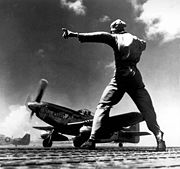
(Image: P-51D My Girl at Iwo Jima where fighters were based to escort B-29s on bombing missions to Japan in 1945)
In April 1942, the RAF's Air Fighting Development Unit (AFDU) tested the Mustang and found its performance inadequate at higher altitudes. As such it was to be used to replace the Tomahawk in Army Cooperation Command squadrons but the commanding officer was so impressed with its manoeuvrability and low-altitude speeds that he invited Ronnie Harker from Rolls Royce's Flight Test establishment to fly it. Rolls-Royce engineers rapidly realized that equipping the Mustang with a Merlin 61 engine with its two speed, two stage supercharger would substantially improve performance and started converting five aircraft as the Mustang X. Apart from the engine installation, which utilised custom built engine bearers designed by Rolls-Royce and a standard 10 ft 9 in (3.3 m) diameter, four bladed Rotol propeller from a Spitfire Mk. IX, the Mustang X was a straight-forward adaptation of the Mustang I airframe, keeping the same radiator duct design. The Vice-Chief of the Air Staff, Air Marshal Sir Wilfrid R. Freeman, lobbied vociferously for Merlin-powered Mustangs, insisting two of the five experimental Mustang Xs be handed over to Carl Spaatz for trials and evaluation by the U.S. 8th Air Force in Britain.
The high-altitude performance improvement was astonishing: the Mustang X (AM208) reached 433 mph (697 km/h) at 22,000 ft (6,700 m) and AL975 tested at an absolute ceiling of 40,600 ft (12,400 m).
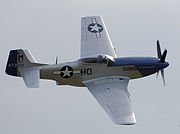
(Image: Miss Helen, a P-51D in its wartime markings as flown by Capt Raymond H. Littge of the 487 FS, 352 FG, on aerial display in 2007. It is the last original 352 FG P-51 known to exist)
The XP-51B prototypes were a more thorough adaptation of the airframe, with a tailor made engine installation and a complete redesign of the radiator duct. The airframe itself was strengthened, with the fuselage and engine mount area receiving more formers because of the greater weight of the Packard Merlin V-1650-3, 1,690 lb (770 kg) compared with the Allison V-1710's 1,335 lb (606 kg). The engine cowling was completely redesigned to house the Packard Merlin which, because of the intercooler radiator mounted on the supercharger casing, was 5 inches (130 mm) taller and used an updraught induction system rather than the downdraught carburetor of the Allison. The new engine drove a four bladed 11 ft 2 in (3.4 m) diameter Hamilton Standard propeller which featured cuffs of hard molded rubber. A new radiator, supercharger intercooler and oil radiator installation in a new fuselage duct was designed to cater for the increased cooling requirements of the Merlin.
I t was decided that the armament of the new, P-51B (NA 102) would be the four .50 Cal Browning M2/AN machine guns (with 350 rpg for the inboard guns and 280 rpg for the outboard) of the P-51A and the bomb rack/external drop tank installation (adapted from the A-36) would also be used; the racks were rated to be able to carry up to 500 lb (230 kg) of ordnance and were also capable of carrying drop tanks. The weapons were aimed using an N-3B optical gunsight fitted with an A-1 head assembly which allowed it to be used as a gun or bomb sight through varying the angle of the reflector glass.
t was decided that the armament of the new, P-51B (NA 102) would be the four .50 Cal Browning M2/AN machine guns (with 350 rpg for the inboard guns and 280 rpg for the outboard) of the P-51A and the bomb rack/external drop tank installation (adapted from the A-36) would also be used; the racks were rated to be able to carry up to 500 lb (230 kg) of ordnance and were also capable of carrying drop tanks. The weapons were aimed using an N-3B optical gunsight fitted with an A-1 head assembly which allowed it to be used as a gun or bomb sight through varying the angle of the reflector glass.
Pilots were also given the option of having ring and bead sights mounted on the top engine cowling formers. This option was discontinued with the later Ds.
The first XP-51Bs started test flying in December 1942. After sustained lobbying at the highest level, American production was started in early 1943 with the B (NA-102) being manufactured at Inglewood, California, and the C (NA-103) at a new plant in Dallas, Texas, which was in operation by summer 1943. The RAF named these models Mustang III. In performance tests, the P-51B reached 441 mph/709.70 km/h (exactly two-thirds supersonic speed at altitude) at 25,000 ft (7.600 m) and the subsequent extended range made possible by the use of drop tanks enabled the Merlin-powered Mustang to be introduced as a bomber escort.
The range would be further increased with the introduction of an 85 gallon self-sealing fuel tank aft of the pilot's seat, starting with the B-5NA series. When this tank was full the c-g of the Mustang was moved dangerously close to the aft limit, as a result of which maneuvers were restricted until the tank was down to about 25 gallons and the external tanks had been dropped. Problems with high-speed "porpoising" of the P-51Bs and Cs with the fuselage tanks would lead to the replacement of the fabric covered elevators with metal covered surfaces and a reduction of the tailplane incidence.
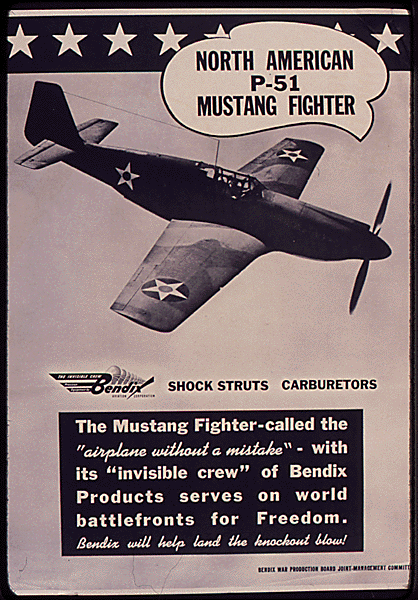 Despite these modifications the P-51 Bs and Cs and the newer Ds and Ks experienced low speed handling problems that could result in an involuntary "snap-roll" under certain conditions of air speed, angle of attack, gross weight and center of gravity. Several crash reports tell of P-51Bs and Cs crashing because horizontal stabilizers were torn off during maneuvering. As a result of these problems a modification kit consisting of a dorsal fin was manufactured. One report stated:
Despite these modifications the P-51 Bs and Cs and the newer Ds and Ks experienced low speed handling problems that could result in an involuntary "snap-roll" under certain conditions of air speed, angle of attack, gross weight and center of gravity. Several crash reports tell of P-51Bs and Cs crashing because horizontal stabilizers were torn off during maneuvering. As a result of these problems a modification kit consisting of a dorsal fin was manufactured. One report stated:
"Unless a dorsal fin is installed on the P-51B, P-51C and P-51D airplanes, a snap roll may result when attempting a slow roll. The horizontal stabilizer will not withstand the effects of a snap roll. To prevent recurrence the stabilizer should be reinforced in accordance with T.O. 01-60J-18 dated 8 April 1944 and a dorsal fin should be installed. Dorsal fin kits are being made available to overseas activities"
These kits became available in August 1944 and were fitted to Bs and Cs and to Ds and Ks. Also incorporated was a change to the rudder trim tabs, which would help prevent the pilot over-controlling the aircraft and creating heavy loads on the tail unit.
P-51Bs and Cs started to arrive in England in August and October 1943. The P-51B/C versions were sent to 15 fighter groups that were part of the 8th and 9th Air Forces in England, and the 12th and 15th in Italy (the southern part of Italy was under Allied control by late 1943). Other deployments included the China Burma India Theater (CBI).
Allied strategists quickly exploited the long-range fighter as a bomber escort. It was largely due to the P-51 that daylight bombing raids deep into German territory became possible without prohibitive bomber losses in late 1943.
A number of the P-51B and P-51C aircraft were fitted for photo reconnaissance and designated F-6C.
P-51D and P-51K
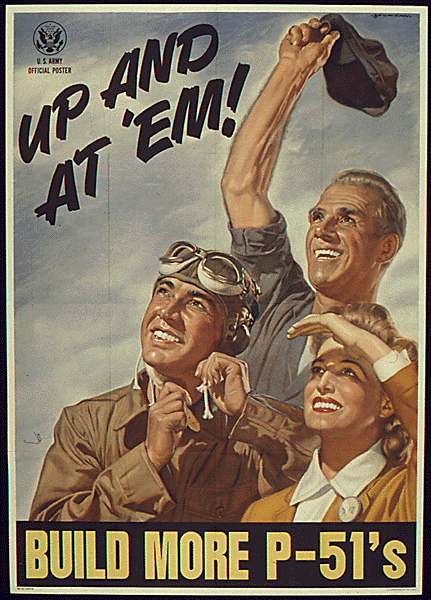 One of the few remaining complaints with the Merlin-powered aircraft was a poor rearward view. This was a common problem in most fighter designs of the era, which had only been recognized by the British after the Battle of Britain proved the value of an all-around view. In order to improve the view from the Mustang at least partially, the British had field-modified some Mustangs with fishbowl-shaped sliding canopies called "Malcolm Hoods" - much like those on Spitfires. Eventually all Mk IIIs, along with some American P-51B/Cs, were equipped with Malcolm Hoods.
One of the few remaining complaints with the Merlin-powered aircraft was a poor rearward view. This was a common problem in most fighter designs of the era, which had only been recognized by the British after the Battle of Britain proved the value of an all-around view. In order to improve the view from the Mustang at least partially, the British had field-modified some Mustangs with fishbowl-shaped sliding canopies called "Malcolm Hoods" - much like those on Spitfires. Eventually all Mk IIIs, along with some American P-51B/Cs, were equipped with Malcolm Hoods.
A better solution to the problem was the "teardrop" or "bubble" canopy. Originally developed as part of the Miles M.20 project, these newer canopies were in the process of being adapted to most British designs, eventually appearing on Typhoons, Tempests and later-built Spitfires. North American adapted several NA-106 prototypes with a bubble canopy, cutting away the decking behind the cockpit, resulting in substantially improved vision to the rear. This led to the production P-51D (NA-109), considered the definitive Mustang.
A common misconception is that the cutting down of the rear fuselage to mount the bubble canopy reduced stability requiring the addition of a dorsal fin to the forward base of the vertical tail. In fact, as described, stability problems affected the earlier Bs and Cs, as well as the subsequent D/K models; this was partly attributable to the 85 gallon fuselage fuel tank which had been installed during production of the P-51B-5-NA.
Among other modifications, armament was increased with the addition of two M2 machine guns, bringing the total to six. The inner pair of machine guns had 400 rounds each, and the others had 270 rounds, for a total of 1,880. In previous P-51s, the M2s were mounted at an extreme side angle to allow access to the feed chutes from the ammunition trays. This angled mounting had caused problems of congestion and jamming of the ammunition and spent casings and links, leading to frequent complaints of jamming during combat maneuvers. The new arrangement allowed the M2s to be mounted upright, remedying most of the jamming problems. The .50 caliber Browning machine guns, although not firing an explosive projectile, had excellent ballistics and proved adequate against the Fw 190 and Bf 109 fighters that were the main USAAF opponents at the time. The wing racks fitted to the P-51D/K series were strengthened and were able to carry up to 1,000 lb (450 kg) of ordnance. Later models had under-wing rocket pylons added to carry up to ten rockets per plane.
The gunsight was changed from the N-3B to the N-9 before the introduction in September 1944 of the K-14B gyro-computing sight.
Alterations to the undercarriage up-locks and inner-door retracting mechanisms meant that there was a change to the shape of the inner wing leading edge, which was raked forward slightly, increasing the wing area and creating a distinctive "kink" in the leading edges of the wings.
The P-51D became the most widely produced variant of the Mustang. A Dallas-built version of the P-51D, designated the P-51K, was equipped with an Aeroproducts propeller in place of the Hamilton Standard propeller, as well as a larger, differently configured canopy and other minor alterations (the vent panel was different). The hollow-bladed Aeroproducts propeller was unreliable with dangerous vibrations at full throttle due to manufacturing problems and was eventually replaced by the Hamilton Standard. By the time of the Korean war most F-51s were equipped with "uncuffed" Hamilton Standard propellers with wider, blunt tipped blades. The photo reconnaissance versions of the P-51D and P-51K were designated F-6D and F-6K respectively. The RAF assigned the name Mustang IV to the D model and Mustang IVA to K models.
The P-51D/K started arriving in Europe in mid-1944 and quickly became the primary USAAF fighter in the theater. It was produced in larger numbers than any other Mustang variant. Nevertheless, by the end of the war, roughly half of all operational Mustangs were still B or C models.
Concern over the USAAF's inability to escort B-29s all the way to mainland Japan resulted in the highly classified "Seahorse" project. In late 1944 naval aviator (and later test pilot) Bob Elder flew carrier suitability trials with a modified P-51D. The project was canceled after U.S. Marines secured the Japanese island of Iwo Jima and its airfields, making it possible for standard P-51D models to accompany B-29s all the way to the Japanese home islands and back.
During 1945–48, P-51Ds were also built under licence in Australia by the Commonwealth Aircraft Corporation.
XP-51F, XP-51G and XP-51J
The USAAF required airframes built to their acceleration standard of 8.33 g (82 m/s²), a higher load factor than that used by the British standard of 5.33 g (52 m/s²) for their fighters. Reducing the load factor to 5.33 would allow weight to be removed, and both the USAAF and the RAF were interested in the potential performance boost.
A subtle change made in the lightweight Mustangs was the use of an improved NACA 66 series airfoil and a slightly thinner wing than that used by earlier Mustangs.
In 1943, North American submitted a proposal to re-design the P-51D as model NA-105, which was accepted by the USAAF. Modifications included changes to the cowling, a simplified undercarriage with smaller wheels and disc brakes, and a larger canopy. The designation XP-51F was assigned to prototypes powered with V-1650 engines (a small number of XP-51Fs were passed to the British as the Mustang V) and XP-51G to those with reverse lend/lease Merlin RM 14 SM engines.
A third lightweight prototype powered by an Allison V-1710-119 engine was added to the development program. This aircraft was designated XP-51J. Since the engine was insufficiently developed, the XP-51J was loaned to Allison for engine development. None of these experimental "lightweights" went into production.
The P-51H (NA-126) was the final production Mustang, embodying the experience gained in the development of the XP-51F and XP-51G aircraft. This aircraft, with minor differences as the NA-129, came too late to participate in World War II, but it brought the development of the Mustang to a peak as one of the fastest production piston engine fighters to see service.
P-51H
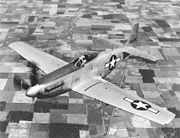
(Image: P-51H in flight)
The P-51H used the new V-1650-9 engine, a version of the Merlin that included Simmons automatic supercharger boost control with water injection, allowing War Emergency Power as high as 2218 hp (1,500 kW). Differences between the P-51D included lengthening the fuselage and increasing the height of the tailfin, which greatly reduced the tendency to yaw. The canopy resembled the P-51D style, over a somewhat raised pilot's position. Service access to the guns and ammunition was also improved. With the new airframe several hundred pounds lighter, the extra power and a more streamlined radiator, the P-51H was among the fastest propeller fighters ever, able to reach 487 mph (784 km/h or Mach 0.74) at 25,000 ft (7,600 m).
The P-51H was designed to complement the P-47N as the primary aircraft for the invasion of Japan with 2,000 ordered to be manufactured at Inglewood. Production was just ramping up with 555 delivered when the war ended. Production serial numbers:
P-51H-1-NA 44-64160 – 44-64179
P-51H-5-NA 44-64180 – 44-64459
P-51H-10-NA 44-64460 – 44-64714
Additional orders, already on the books, were cancelled. With the cutback in production, the variants of the P-51H with different versions of the Merlin engine were produced in either limited numbers or terminated. These included the P-51L, similar to the P-51H but utilizing the 2,270 horsepower (1,690 kW) V-1650-11 Merlin engine, which was never built; and its Dallas-built version, the P-51M or NA-124 which utilized the V-1650-9A Merlin engine lacking water injection and therefore rated for lower maximum power, of which one was built out of the original 1629 ordered, serial number 45-11743.
Although some P-51Hs were issued to operational units, none saw combat in World War II, and in postwar service, most were issued to reserve units. One aircraft was provided to the RAF for testing and evaluation. Serial number 44-64192 was designated BuNo 09064 and used by the U.S. Navy to test transonic airfoil designs, then returned to the Air National Guard in 1952. The P-51H was not used for combat in the Korean War despite its improved handling characteristics, since the P-51D was available in much larger numbers and was a proven commodity.
Many of the aerodynamic advances of the P-51 (including the laminar flow wing) were carried over to North American's next generation of jet-powered fighters, the Navy FJ Fury and Air Force F-86 Sabre. The wings, empennage and canopy of the first straight-winged variant of the Fury (the FJ-1) and the unbuilt preliminary prototypes of the P-86/F-86 strongly resembled those of the Mustang before the aircraft were modified with swept-wing designs.
Experimental Mustangs
In early 1944 the first P-51A-1NA 43-6003 was fitted and tested with a lightweight retractable ski kit replacing the wheels. This conversion was made in response to a perceived requirement for aircraft which would operate away from prepared airstrips. The main oleo leg fairings were retained, but the main wheel doors and tail wheel doors were removed for the tests. When the undercarriage was retracted the main gear skis were housed in the space in the lower engine compartment made available by the removal of the fuselage .50 cal Brownings from the P-51As. The entire installation added 390 lb (180 kg) to the aircraft weight and required that the operating pressure of the hydraulic system had to be increased from 1,000 psi to 1,200 psi. Flight tests showed that ground handling was good and the Mustang could take-off and land in a field length of 1,000 feet (300 m); the maximum speed was 18 mph (29 km/h) lower, although it was thought that fairings over the retracted skis would compensate.
On 15 November 1944 a navalized P-51D-5NA 414017 started flight tests from the deck of the carrier Shangri-La. This Mustang had been fitted with an arrestor hook which was attached to a reinforced bulkhead behind the tail wheel opening; the hook was housed in a streamlined position under the rudder fairing and could be released from the cockpit. The tests showed that the Mustang could be flown off the carrier deck without the aid of a catapult, using a flap setting of 20 degrees down and 5 degrees of up elevator. Landings were found to be easy and by allowing the tail wheel to contact the deck before the main gear the aircraft could be stopped in a minimum distance.
While North American were concentrating on improving the performance of the P-51 through the development of the "lightweight" Mustangs, in Britain other avenues of development were being pursued. To this end at least two Mustang IIIs (P-51Bs and Cs) FX858 and FX901 were fitted with different Merlin engine variants. The first of these, FX858, was fitted with a Merlin 100 by Rolls-Royce at Hucknall; this engine was similar to the RM 14 SM fitted to the XP-51G and was capable of generating 2,080 hp (1,551 kW) at 22,800 ft (6,949 m) using a boost pressure of +25 lbs (equivalent to 80" Hg) in "war emergency" setting. With this engine FX858 reached a maximum speed of 453 mph (729 km/h) at 18,000 ft (5,486 m), and this could be maintained to 25,000 ft (7,620 m). The climb rate was 4,160 ft/min (21.13 m/s) at 14,000 ft (4,267).
FX901 was fitted with a Merlin 113 (also used in the de Havilland Mosquito B. Mk 35). This engine was similar to the 100 but it was fitted with a supercharger rated for higher altitudes. FX901 was capable of 454 mph (730 km/h) at 30,000 ft (9,144 m) and 414 mph (666 km/h) at 40,000 ft (12,192 m).
Operational history
U.S. operational service
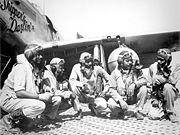
(Image: Pilots of the elite, all-African American 332nd Fighter Group (the "Tuskegee Airmen") at Ramitelli, Italy. From left, Lt. Dempsey W. Morgran, Lt. Carroll S. Woods, Lt. Robert H. Nelron, Jr., Capt. Andrew D. Turner and Lt. Clarence P. Lester)
At the Casablanca Conference, the Allies formulated the Combined Bomber Offensive (CBO) plan for "round-the-clock" bombing by the RAF at night and the USAAF by day. American pre-war bombardment doctrine held that large formations of heavy bombers flying at high altitudes would be able to defend themselves against enemy interceptors with minimal fighter escort, so that precision daylight bombing using the Norden bombsight would be effective.
Both the RAF and Luftwaffe had attempted daylight bombing and discontinued it, believing advancements in single-engine fighters made multi-engined bombers too vulnerable, contrary to Giulio Douhet's thesis. The RAF had worried about this in the mid-1930s and had decided to produce an all night-bomber force, but initially began bombing operations by day. The Germans used extensive daylight bombing during the Battle of Britain in preparation for a possible invasion. Due to the high casualty rates, the Luftwaffe soon switched to night bombing (see The Blitz). Bomber Command followed suit in its raids over Germany.
Initial USAAF efforts were inconclusive because of the limited scale. In June 1943, the Combined Chiefs of Staff issued the Pointblank Directive to destroy the Luftwaffe before the invasion of Europe, putting the CBO into full implementation. The Eighth Air Force heavy bomber force conducted a series of deep penetration raids into Germany beyond the range of available escort fighters. German fighter reaction was fierce and bomber losses were severe — 20 percent in an October 14 attack on the German ball-bearing industry. This made it costly to continue such long-range raids without adequate fighter escort.
The Lockheed P-38 Lightning had the range to escort the bombers, but was available in very limited numbers in the European theater due to its Allison engines proving difficult to maintain. With the extensive use of the P-38 in the Pacific Theater of Operations, where its twin engines were deemed vital to long-range "over-water" operations, nearly all European-based P-38 units converted to the P-51 in 1944. The Republic P-47 Thunderbolt was capable of meeting the Luftwaffe on more than even terms, but did not at the time have sufficient range. The Mustang changed all that. In general terms, the Mustang was at least as simple as other aircraft of its era. It used a single, well-understood, reliable engine, and had internal space for a huge fuel load. With external fuel tanks, it could accompany the bombers all the way to Germany and back.
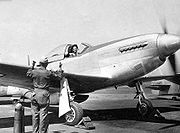
(Image: Florene Watson Women Airforce Service Pilots, preparing a P-51D-5-NA for a ferry flight from the factory at Inglewood, CA)
Enough P-51s became available to the 8th and 9th Air Forces in the winter of 1943-44, and when the Pointblank offensive resumed in early 1944, matters changed dramatically. The P-51 proved perfect for the task of escorting bombers all the way to the deepest targets, thus complementing the more numerous P-47s until sufficient Mustangs became available. The Eighth Air Force immediately began to switch its fighter groups to the Mustang, first exchanging arriving P-47 groups for those of the Ninth Air Force using P-51s, then gradually converted its Thunderbolt and Lightning groups until by the end of the year 14 of its 15 groups flew the Mustang.

(Image: Lt. Vernon R Richards, 374th FS, 361st FG. Early production P-51D-5-NA without tail fillet)
Luftwaffe pilots attempted to avoid U.S. fighters by massing in huge numbers well in front of the bombers, attacking in a single pass, then breaking off the attack, allowing escorting fighters little time to react. While not always successful in avoiding contact with escort (as the tremendous loss of German pilots in the spring of 1944 indicates), the threat of mass attacks, and later the "company front" (eight abreast) assaults by armored Sturmgruppe Fw 190s, brought an urgency to attacking the Luftwaffe wherever it could be found. The P-51, particularly with the advent of the K-14 gunsight and the development of "Clobber Colleges" for the in-theater training of fighter pilots in fall 1944, was a decisive element in Allied countermeasures against the Jagdverbände.
Beginning in late February 1944 Eighth Air Force fighter units began systematic strafing attacks on German airfields that picked up in frequency and intensity throughout the spring with the objective of gaining air supremacy over the Normandy battlefield. In general these were conducted by units returning from escort missions, but beginning in March many groups also were assigned airfield attacks instead of bomber support. On 15 April VIII FC began Operation Jackpot, attacks on specific Luftwaffe fighter airfields, and on 21 May these attacks were expanded to include railways, locomotives, and rolling stock used by the Germans for movements of materiel and troops in missions dubbed "Chattanooga". The P-51 also excelled at this mission, although losses were much higher on strafing missions than in air-to-air combat, partially due to the vulnerability of the Mustang's cooling system to small arms hits. Like other fighters using liquid cooled engines, the Mustang's coolant system could be punctured by a hit from a single bullet.
The numerical superiority of the USAAF fighters, superb flying characteristics of the P-51 and pilot proficiency helped cripple the Luftwaffe's fighter force. As a result, the fighter threat to US, and later British bombers, was greatly diminished by summer 1944.
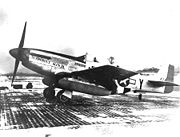
(Image: Chuck Yeager's P-51D-15-NA Glamorous Glennis III, is the aircraft in which the future test pilot achieved most of his 12.5 kills)
P-51s also distinguished themselves against advanced enemy rockets and aircraft. A P-51B/C with high-octane fuel was fast enough to pursue the V-1s launched toward London. The Me 163 Komet rocket interceptors and Me 262 jet fighters were considerably faster than the P-51, but as all aircraft are, were vulnerable on take-off. Chuck Yeager, flying a P-51D, was one of the first American pilots to shoot down a Me 262 when he surprised it during its landing approach. On 7 October 1944 Lt. Urban Drew, of the 365th Fighter Group, went one better. During a fighter sweep he surprised two Me 262s on take-off and shot them down. On the same day Hubert Zemke, now flying Mustangs, shot down what he thought was a Bf 109, only for the gun camera film to reveal a Me 262. On 1 November 1944, the Mustang pilots once again demonstrated that the threat could be contained with numbers. While flying as escorts for B-17s, the 20th Fighter Group was attacked by a lone Me 262, which destroyed a solitary P-51. The Me 262 then attempted to attack the bombers, only to be cut off by a mixed formation of P-51s and P-47s. The Fighter Groups competed for the kill. Eventually a P-47 pilot of the 56th, and Mustang pilots Lt Gerbe and Groce of the 352nd Fighter Groups, shared the kill.
The Eighth, Ninth and Fifteenth Air Forces' P-51 groups, all but three of which flew another type before converting to the Mustang, claimed some 4,950 aircraft shot down (about half of all USAAF claims in the European theater) and 4,131 destroyed on the ground. Losses were about 2520 aircraft.
One of these groups, the Eighth Air Force's 4th Fighter Group, was the overall top-scoring fighter group in Europe with 1,016 enemy aircraft claimed destroyed. This included 550 claimed in aerial combat and 466 claimed on the ground.
In aerial combat, the top-scoring P-51 units (both of which exclusively flew Mustangs) were the 357th Fighter Group of the Eighth Air Force with 595 air-to-air combat victories, and the Ninth Air Force's 354th Fighter Group with 701, which made it the top scoring outfit in aerial combat of all fighter groups of any type. Martin Bowman reports that in the ETO Mustangs flew 213,873 sorties and lost 2,520 aircraft to all causes.
P-51s were deployed in the Far East later in 1944, operating in close-support and escort missions as well as operating in the Tactical Photo Reconnaissance role.
Post World War II
In the aftermath of World War II, the USAAF consolidated much of its wartime combat force and selected the P-51 as a "standard" piston engine fighter while other types such as the P-38 and P-47 were withdrawn or given substantially reduced roles. However, as more advanced jet fighters (P-80 and P-84) were being introduced, the P-51 was relegated to secondary status.
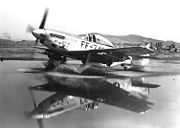
(Image: F-51 Mustang taxis through a puddle in Korea, laden with bombs and rockets)
In 1947, the newly-formed USAF Strategic Air Command employed Mustangs alongside F-6 Mustangs and F-82 Twin Mustangs, due to their range capabilities. In 1948, the designation P-51 (P for pursuit) was changed to F-51 (F for fighter) and the existing F designator for photographic reconnaissance aircraft was dropped because of a new designation scheme throughout the USAF. Aircraft still in service in the USAF or Air National Guard (ANG) when the system was changed included: F-51B, F-51D, F-51K, RF-51D (formerly F-6D), RF-51K (formerly F-6K), and TRF-51D (two-seat trainer conversions of F-6Ds). They remained in service from 1946 through 1951. By 1950, although Mustangs continued in service with the USAF and many other nations after the war, the majority of the USAF's Mustangs had been surplussed or transferred to the Air Force Reserve (AFRES) and the Air National Guard (ANG).
During the Korean War, F-51s, though obsolete as fighters, were used as close ground support aircraft and reconnaissance aircraft until the end of the war in 1953. Because of its lighter structure and less availability of spare parts, the newer, faster F-51H was not used in Korea. With the aircraft being used for ground attack, their performance was less of a concern than their ability to carry a load.
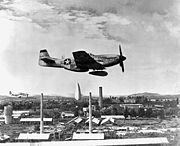
(Image: USAF F-51D dropping napalm on a target in North Korea)
At the start of the Korean War, the Mustang once again proved its usefulness. With the availability of F-51Ds in service and in storage, a substantial number were shipped via aircraft carriers to the combat zone for use initially by both the Republic of Korea Air Force (ROKAF) and USAF. Rather than employing them as interceptors or "pure" fighters, the F-51 was given the task of ground attack, fitted with rockets and bombs. After the initial invasion from North Korea, USAF units were forced to fly from bases in Japan, and F-51Ds could hit targets in Korea that short-ranged F-80 jet fighters could not. A major concern over the vulnerability of the cooling system was realized in heavy losses due to ground fire. Mustangs continued flying with USAF and Republic of Korea Air Force (ROKAF) fighter-bomber units on close support and interdiction missions in Korea until they were largely replaced by Republic F-84 and Grumman Panther jet fighter-bombers in 1953. No. 77 Squadron Royal Australian Air Force (RAAF) operated Australian-built Mustangs as part of British Commonwealth Forces Korea, replacing them with Gloster Meteor F8s in 1951. No. 2 Squadron South African Air Force (SAAF) operated US-built Mustangs as part of the US 18th Fighter Bomber Wing, suffering heavy losses by 1953, when it converted to the F-86 Sabre.
F-51s flew in the Air Force Reserve and Air National Guard throughout the 1950s. The last American USAF Mustang was F-51D-30-NA AF Serial No. 44-74936, which was finally withdrawn from service with the West Virginia Air National Guard in 1957. This aircraft is now on display at the National Museum of the United States Air Force at Wright-Patterson AFB in Dayton, Ohio. It is, however, painted as P-51D-15-NA Ser No. 44-15174.

(Image: West Virginia Air National Guard F-51D. Note: postwar "uncuffed" propeller unit
The final withdrawal of the Mustang from USAF dumped hundreds of P-51s out onto the civilian market. The rights to the Mustang design were purchased from North American by the Cavalier Aircraft Corporation, which attempted to market the surplus Mustang aircraft both in the U.S. and overseas. In 1967 and again in 1972, the USAF procured batches of remanufactured Mustangs from Cavalier, most of them destined for air forces in South America and Asia that were participating in the Military Assistance Program (MAP). These aircraft were remanufactured from existing original F-51D airframes but were fitted with new V-1650-7 engines, a new radio fit, tall F-51H-type vertical tails, and a stronger wing which could carry six 0.50-inch (13 mm) machine guns and a total of eight underwing hardpoints. Two 1000-pound bombs and six five-inch (127 mm) rockets could be carried. They all had an original F-51D-type canopy, but carried a second seat for an observer behind the pilot. One additional Mustang was a two-seat dual-control TF-51D (67-14866) with an enlarged canopy and only four wing guns. Although these remanufactured Mustangs were intended for sale to South American and Asian nations through the Military Assistance Program (MAP), they were delivered to the USAF with full USAF markings. They were, however, allocated new serial numbers (67-14862/14866, 67-22579/22582 and 72-1526/1541).
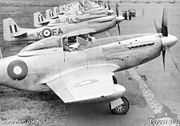
(Image: Australian P-51Ds of 82 Squadron RAAF in Bofu, Japan as part of the British Commonwealth Occupation Force, in 1947)
The last U.S. military use of the F-51 was in 1968, when the U. S. Army employed a vintage F-51D (44-72990) as a chase aircraft for the Lockheed YAH-56 Cheyenne armed helicopter project. This aircraft was so successful that the Army ordered two F-51Ds from Cavalier in 1968 for use at Fort Rucker as chase planes. They were assigned the serials 68-15795 and 65-15796. These F-51s had wingtip fuel tanks and were unarmed. Following the end of the Cheyenne program, these two chase aircraft were used for other projects. One of them (68-15795) was fitted with a 106 mm recoilless rifle for evaluation of the weapon's value in attacking fortified ground targets.
The F-51 was adopted by many foreign air forces and continued to be an effective fighter into the mid 1980s with smaller air arms. The last Mustang ever downed in battle occurred during Operation Power Pack in the Dominican Republic in 1965, with the last aircraft finally being retired by the Dominican Air Force (FAD) in 1984.
P-51s and civil aviation
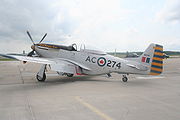
(Image: Restored P-51D in the markings of No. 402 "City of Winnipeg" RCAF Auxiliary Squadron)
Many P-51s were sold as surplus after the war, often for as little as $1,500. Some were sold to former wartime fliers or other aficionados for personal use, while others were modified for air racing.
One of the most prominent Mustangs involved in air racing was a surplus P-51C purchased by Paul Mantz, a film stunt pilot. The aircraft was modified by creating a "wet wing", sealing the wing to create a giant fuel tank in each wing, which eliminated the need for fuel stops or drag-inducing drop tanks. This Mustang, called "Blaze of Noon", came in first in the 1946 and 1947 Bendix Air Races, second in the 1948 Bendix and third in the 1949 Bendix. He also set a U.S. coast-to-coast record in 1947. The Mantz Mustang was sold to Charles F. Blair Jr (future husband of Maureen O'Hara) and re-named "Excaliber III". Blair used it to set a New York-to-London record in 1951. Later that same year he flew from Norway to Fairbanks, Alaska, via the North Pole, proving that navigation via sun sights was possible over the magnetic north pole region. For this feat, he was awarded the Harmon Trophy and the Air Force was forced to change its thoughts on a possible Soviet air strike from the north. This Mustang now resides in the National Air and Space Museum at Steven F. Udvar-Hazy Center.
The most prominent firm to convert Mustangs to civilian use was Trans-Florida Aviation, later renamed Cavalier Aircraft Corporation, which produced the Cavalier Mustang. Modifications included a taller tailfin and wingtip tanks. A number of conversions included a Cavalier Mustang specialty: a "tight" second seat added in the space formerly occupied by the military radio and fuselage fuel tank.
Ironically, in the late 1960s and early 1970s when the United States Department of Defense wished to supply aircraft to South American countries and later Indonesia, for close air support and counter insurgency, it turned to Cavalier to return some of their civilian conversions back to updated military specifications.
The P-51 is perhaps the most sought after of all warbirds on the civilian market; the average price usually exceeds $1 million, even for only partially restored aircraft. Some privately owned P-51s are still flying, often associated with organizations such as the Commemorative Air Force (formerly the Confederate Air Force).
Variants
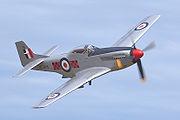
(Image: P-51D in No. 3 (Canterbury) TAF livery, performing at 2007 Wings over Wairarapa airshow)
NA-73X
The initial prototype was designated the NA-73X by the manufacturer, North American Aviation.
Mustang I
The first production contract was awarded by the British for 320 NA-73 fighters. This aircraft was named Mustang I by the British. A second British contract for 300 more Mustang Is was assigned a model number of NA-83 by North American.
XP-51
Two aircraft of this lot delivered to the USAAF were designated XP-51.
P-51
In September 1940, 150 aircraft designated NA-91 by North American were ordered under the Lend/Lease program. These were designated by the USAAF as P-51 and initially named the Apache although this name was dropped early-on for Mustang. The British designated this model as Mustang IA. They were equipped with four long-barrelled 20 mm Hispano-Suiza Mk II cannon instead of machine guns. A number of aircraft from this lot were fitted out by the USAAF as photo reconnaissance aircraft and designated F-6A. The British would fit a number of Mustang I fighters with photographic reconnaissance equipment as well. Also, two aircraft of this lot were fitted with the Packard-built Merlin engine and were designated by North American as model NA-101 and by the USAAF initially as the XP-78, but re-designated quickly to XP-51B.

(Image: A Polish Air Force personal Mustang III (not commisioned to any Squadron) flown by Wing Commander Tadeusz Nowierski, C/O of 133(Polish) Fighter Wing, RAF Coolham, July 1944)
In early 1942, the USAAF ordered a lot of 500 aircraft modified as dive bombers that were designated A-36A. North American assigned the aircraft the model number NA-97. This model became the first USAAF Mustang to see combat. One aircraft was passed to the British who gave it the name Mustang I (Dive Bomber).
Following the A-36A order the USAAF ordered 310 model NA-99 fighters that were designated P-51A by the USAAF. and Mustang II by the RAF. A number of this lot of aircraft were equipped with K-24 cameras and designated F-6B. All these models of the Mustang were equipped with Allison V-1710 engines except the prototype XP-51B.
Beginning with the model NA-102 Mustang, the Packard V-1650 replaced the Allison. In the summer of 1943 Mustang production was begun at a new plant in Dallas, Texas as well as at the existing facility in Inglewood, California. The model NA-102 was produced as the P-51B in Inglewood while the NA-103 as the P-51C was produced at Dallas. The RAF named these models Mustang III. Again, a number of the P-51B and P-51C aircraft were fitted for photo Reconnaissance and designated F-6C.
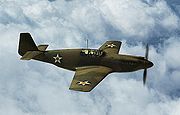
(Image: Early Allison-powered P-51, October 1942)
The prototypes of the bubble canopy change were designated model NA-106 by North American and P-51D by the USAAF. The production version, while retaining the P-51D designation, was assigned a model number NA-109 by North American. The "D" became the most widely produced variant of the Mustang. A variation of the P-51D equipped with an Aeroproducts propeller in place of the Hamilton Standard propeller was designated the P-51K. The photo versions of the P-51D and P-51K were designated F-6D and F-6K respectfully. The RAF assigned the name Mustang IV to the "D" model and Mustang IVA to "K" models.
As the USAAF specifications required airframe design to a higher load factor than that used by British for their fighters, consideration was given to re-designing the Mustang to the lower British requirements in order to reduce the weight of the aircraft and thus improve performance. In 1943, North American submitted a proposal to do the re-design as model NA-105, which was accepted by the USAAF. The designation XP-51F was assigned for prototypes powered with V-1650 engines and XP-51G to those with reverse lend/lease Merlin 145M engines. Modifications included changes to the cowling, a simplified undercarriage with smaller wheels and disk brakes, and a larger canopy. A third prototype was added to the development that was powered by an Allison V-1710 engine. This aircraft was designated XP-51J. As the engine was insufficiently developed the XP-51J was loaned to Allison for engine development. A small number of XP-51Fs were passed to the British as the Mustang V.
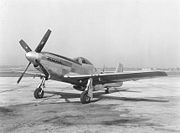
(Image: P-51D on runway)
The final production Mustang, the P-51H embodied the experience gained in the development of the lightweight XP-51F and XP-51G aircraft. This aircraft, model NA-126 and with minor differences NA-129, came too late to participate in World War II, but it brought the development of the Mustang to a peak and was one of the fastest production piston engine fighters to see service. The P-51H used the Merlin V-1659-9 engine, equipped with Simmons automatic boost control and water injection, allowing War Emergency Power as high as 2,218 horsepower (1,654 kW). Some of the weight savings inherited from the XP-51F and XP-51G were invested in lengthening the fuselage and increasing the height of the tailfin, greatly reducing the tendency to yaw, and in restoring the fuselage fuel tank. The canopy was changed back to more nearly resemble the P-51D style, over a somewhat raised pilot's position. Service access to the guns and ammunition was improved. The P-51H was designed to complement the P-47N as the primary aircraft for the invasion of Japan and 2,000 were ordered to be built at the Inglewood plant. With the solution to the problem of yaw control, the P-51H was now considered a suitable candidate for testing as an aircraft carrier based fighter; but with the end of the war, the testing was cut short, and production was halted after 555 aircraft were built. Although some P-51Hs were issued to operational units, none saw combat. One aircraft was given to the RAF for testing and evaluation. Serial number 44-64192 was re-serialed as BuNo 09064 and used by the U.S. Navy to test transonic airfoil designs, then returned to the Air National Guard in 1952. The P-51H was not used for combat in the Korean War despite its improved handling characteristics, due to the lack of experience with durability of the lighter airframe under combat conditions as well as limited numbers in the USAF inventory.
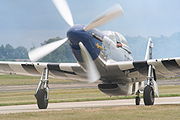
(Image: One of many P-51D Mustangs at Oshkosh 2005, in the livery of the 352nd Fighter Group, RAF Bodney, UK)
With the cutback in production the variants of the P-51H with different versions of the Merlin engine were produced in either limited numbers or terminated. These included the P-51L, similar to the P-51H but utilizing the 2,270 horsepower (1,690 kW) V-1650-11 engine, which was never built; and its Dallas-built version, the P-51M or NA-124 which utilized the V-1650-9A engine lacking water injection and therefore rated for lower maximum power, of which one was built out of the original 1629 ordered, AAF Serial Number 45-11743.
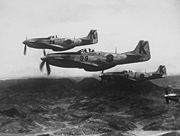
(Image: The F-51D in ROKAF service)
F-51
Redesignation of all P-51s in 1947 in the U.S. Air Force, Air Force Reserve and Air National Guard following establishment of the U.S. Air Force as a separate service.
TF-51D
Twin seat/dual control version of the F-51 with four versus six guns.
Production
-NA.73X Prototype: One built
-P-51: 150 built
-P-51A: 310 built at Inglewood, California
-P-51B: 1,988 built at Inglewood
-P-51C: 1,750 built at Dallas, Texas
-P-51D: A total of 8,156 were built: 6,502 at Inglewood, 1,454 at Dallas and 200 by CAC at Fisherman's Bend, Australia
-XP-51F: Three built
-XP-51G: Two built
-P-51H: 555 built at Inglewood
-XP-51J: Two built
-P-51K: 1,500 built
-P-51L: None built - cancelled
-P-51M: One built at Dallas
-Mustang I: 620 built
-Mustang III: 852 built
-Mustang IV: 281 built
-Mustang IVA: 595 built
Total number built: 15,875 (among American fighter aircraft second only to the P-47 Thunderbolt)
Scaled replicas
The P-51 has been the subject of numerous sub-scale flying replicas; aside from ever-popular R/C-controlled aircraft, several kitplane manufacturers offer 1/2, 2/3, and 3/4-scale replicas capable of comfortably seating one (or even two) pilot(s) and offering high performance combined with more forgiving flight characteristics. Such aircraft include the Titan T-51 Mustang and Thunder Mustang.
Survivors
Among the 287 current airframes and the 154 "flying" Mustangs are the following:
-XP-51 41-038 Original prototype on display, Oshkosh
-P-51A-1NA Mustang in storage for restoration, Kermit Weeks, Polk City, FL
-P-51A-10-NA Mustang now flying and marked as "Miss Virginia" Planes of Fame, Chino, CA
-A-36 Mustang Planes of Fame, Chino, CA
-P-51C-10-NT Mustang flying as "Ina the Macon Belle" of Lt. Lee Archer, the only 5 victory ace of the "Tuskegee Airmen" 332nd FG, 302nd FS. Kermit Weeks, Tamiami FL.
-P-51D (s/n 44-74936) is on display at the National Museum of the United States Air Force in Dayton, Ohio. It was the last P-51 in USAF service as well as the last USAF propeller-driven fighter in operation. It was obtained from the West Virginia Air National Guard in January 1957. It is painted as the P-51D flown by Col. C.L. Sluder, commander of the 325th Fighter Group in Italy in 1944. The name of this aircraft, Shimmy IV, comes from the names of his daughter, Sharon, and his wife, Zimmy.
-P-51D Mustang, Olympic flight museum, Olympia, WA. In flying condition.
-P-51D Mustang, Indiana Aviation Museum, Valparaiso, IN. In flying condition, served with the North Dakota, Alabama, and Kentucky Air National Guards.
-P-51 Mustang (Mk IV), Vintage Wings of Canada, Gatineau, Québec.
-P-51D Mustang, N167F, Scandinavia Historic Flight, painted as "Old Crow," the aircraft of one of the 8th AF aces, Col. Clarence E. "Bud" Anderson of the 357th Fighter Group, 363rd Fighter Squadron.
-P-51D Mustang, SE-BIL, "It's About Time," based in Sweden.
-P-51D Mustang, (P-51D-20NA) Cavanaugh Flight Museum, Addison, Texas. The aircraft is in flying condition.
-P-51D Mustang, 'Spam Can' Planes of Fame, Chino, CA
-P-51D Mustang, 'Wee Willy II' Planes of Fame, Chino, CA
"Ole Yeller," flown by John Bagley at an airshow in Rexburg, ID.
-P-51D Mustang Marked as under restoration Planes of Fame, Chino, CA
-P-51H Mustang 44-64415 Flying, Whittington Bros, Fort Lauderdale, FL
-P-51D "Old Yeller" - Formerly owned by Bob Hoover. In flying condition. Currently owned by John Bagley of Rexburg, ID and displayed at the Legacy Flight Museum
-CA-17 Mk.20 A68-1, N51WB 'Jeannie Too,' flying, Wiley Sanders, Troy, AL.
-CA-18 Kk.21 A68-104, VH-BOB, flying, Bob Eastgate, Australia
-P-51D Mustang, G-BTCD S/NUMBER 44-73419 - Painted to resemble 44-13704, "Ferocious Frankie," Operated by the Old Flying Machine Company, Duxford, Cambridgshire, UK.
-P-51D Mustang, G-SIJJ, 44-072035 - painted to resemble 4464076 "Jumpin Jacques," Operated by the Hangar 11 Collection, North Weald, UK.
-P-51 Mustang of the Philippine Air Force, painted in original markings with "shark mouth," on display at the Air Force Museum, Villamor Air Base, Pasay City, Philippines
-P-51D Mustang "Never Miss" at the Salem Airport in Salem, Oregon. Flying condition.
Popular culture
-Dragonfly Squadron (1953): B-movie flick of Korean War featuring the P-51.
-Battle Hymn (1956), is based on the real-life experiences of Lt. Col. Dean E. Hess (played by Rock Hudson) and his cadre of U.S. Air Force instructors in the early days of the Korean War, training the pilots of the Republic of Korea Air Force and leading them in their baptism of fire in F-51D/Ks.
-The Lady Takes a Flyer (1958), features a P-51D prominently in the final sequence when Lana Turner (as Maggie Colby) crashes dramatically at the end of a perilous ferry flight to England.
-Wings of Fire (1967), made-for-television air race melodrama with P-51 and F8F.
-The Tuskegee Airmen (1995), the story of how a group of African American pilots overcame racist opposition to become one of the finest U.S. fighter groups in World War II, flying P-51s, although the 99th Squadron would have used P-40 and P-39 during their North African stint.
Specifications
P-51D Mustang
General characteristics
-Crew: 1
-Length: 32 ft 3 in (9.83 m)
-Wingspan: 37 ft 0 in (11.28 m)
-Height: 13 ft 8 in (4.17 m)
-Wing area: 235 ft² (21.83 m²)
-Empty weight: 7,635 lb (3,465 kg)
-Loaded weight: 9,200 lb (4,175 kg)
-Max takeoff weight: 12,100 lb (5,490 kg)
-Powerplant: 1× Packard V-1650-7 liquid-cooled supercharged V-12, 1,490 hp (1,111 kW) at 3,000 rpm; 1,720 hp (1,282 kW) at WEP
-Zero-lift drag coefficient: 0.0163
-Drag area: 3.80 ft² (0.35 m²)
-Aspect ratio: 5.83
Performance
-Maximum speed: 437 mph (703 km/h) at 25,000 ft (7,620 m)
-Cruise speed: 362 mph (580 km/h)
-Stall speed: 100 mph (160 km/h)
-Range: 1,650 mi (2,755 km) with external tanks
-Service ceiling: 41,900 ft (12,770 m)
-Rate of climb: 3,200 ft/min (16.3 m/s)
-Wing loading: 39 lb/ft² (192 kg/m²)
-Power/mass: 0.18 hp/lb (300 W/kg)
-Lift-to-drag ratio: 14.6
-Recommended Mach limit 0.8
Armament
-6 × 0.50 in (12.7 mm) machine guns; 400 rounds per gun for the two inboard guns; 270 per outboard gun
-2 hardpoints for up to 2,000 lb (907 kg)
-10 × 5 in (127 mm) rockets
P-51H Mustang
General characteristics
-Crew: 1
-Length: 33 ft 4 in (10.16 m)
-Wingspan: 37 ft 0 in (11.28 m)
-Height: 11 ft 1 in (3.38 m)
-Wing area: 235 ft² (21.83 m²)
-Empty weight: 7,040 lb (3,195 kg)
-Loaded weight: 9,500 lb (4,310 kg)
-Max takeoff weight: 11,500 lb (5,215 kg)
-Powerplant: 1× Packard V-1650-9 liquid-cooled supercharged V-12, 1,490 hp (1,111 kW) at 3,000 rpm, 2,220 hp (1,655 kW) at WEP
Performance
-Maximum speed: 487 mph (784 km/h) at 25,000 ft (7,620 m)
-Range: 1,160 mi (1,865 km) with external tanks
-Service ceiling: 41,600 ft (12,680 m)
-Rate of climb: 3,300 ft/min (16.8 m/s)
-Wing loading: 40.4 lb/ft² (197.4 kg/m²)
-Power/mass: 0.23 hp/lb (385 W/kg)
Armament
-6 × 0.50 in (12.7 mm) Browning machine guns with 1,880 total rounds (400 rounds for each on the inner pair, and 270 rounds for each of the outer two pair), or 4 of the same guns with 1,600 total rounds (400 per gun).
P-51 Mustang for sale.
Source: WikiPedia